Abstract
At the moment, effective interaction between higher schools and business environment in Russia is not built, which undoubtedly prevents the country from moving to a new stage in the development of society and catching up with developed countries in the field of innovative technologies. We have identified the main factor constraining the development of cooperation between universities and business, which is mainly due to the underestimation of university education involvement by high-tech companies. In this paper, we proposed a new interaction model for innovation process actors (universities, business, government) based on the Leydesdorff triple-helix model, the implementation of which is possible provided that the universities fulfill their integration function. In many developed countries, universities already fulfill this function in full, making an incommensurable contribution to the development of the national economy. The integration function of universities can be interpreted as a flow of knowledge created and appropriately supported by the efforts of universities through the activities coordination of all participants. Thus, thanks to the integration function of universities, the most favorable environment for the introduction of innovative activities in general arises and the status of higher schools is increasing. We have also developed a methodology that allows us to select the most priority researches in the transition from the regional level to the district level and from the district level to the national level, thanks to which it is possible to improve the efficiency of the proposed interaction model.
Keywords: Innovationsintegration function of universitiesknowledge-based societytriple-helix model
Introduction
The section "Formation of the institutional environment for innovative development", laid down in the Concept of long-term social and economic development of the Russian Federation for the period until 2020, defines such important tasks as the development and further effective use of mechanisms for interaction between the state apparatus, business structures and society; introduction of institutional changes for the development of SME's through business incubators, technology parks and industrial parks; strengthening the role of research institutes responsible for creating an enabling environment in which long-term investment projects are implemented (Mayer-Schoenberger & Cuciere, 2014).
To move to a knowledge-based economy, where any kind of communication are becoming more accessible due to network technologies (Evseeva, Obukhova, & Tanova, 2017; Aladyshkin, Kulik, Michurin, & Anosova, 2017), Russia needs to improve the level of integration of science, education and business, remove existing institutional and legal barriers in the regulation of the intellectual property market, and also take care of the formation of public-private partnership mechanisms.
Problem Statement
A group of American scientists, led by the Dutch scientist Loet Leydesdorf, applied an information-theoretical approach based on Shannon's entropy calculations to study the knowledge base of the American economy and calculated the synergy of innovation (Leydesdorff, Wagner, Porto-Gomez, Comins, & Phillipse, 2017), which is expressed in the negative value of entropy ( ).
According to the methodology, knowledge-based innovations can arise because of multiple combinations of technological opportunities, market prospects and geographic advantages or limitations.
Russian scientists using this methodology have calculated the knowledge base of the Russian economy. According to the study (Leydesdorff, Perevodchikov, & Uvarov, 2015), the main innovation potential is realized by large companies, while at the small business level, innovation activity is low, despite the high demand for innovation. When the sectors are separated according to the intensity criteria of science, it can be seen that production with high and medium level of technology is not integrated at the regional level (Fig.1 and Fig.
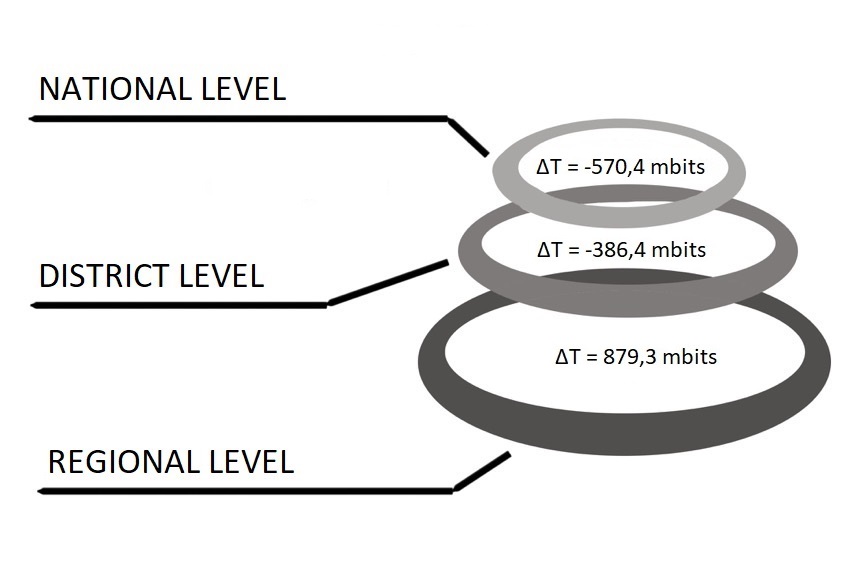
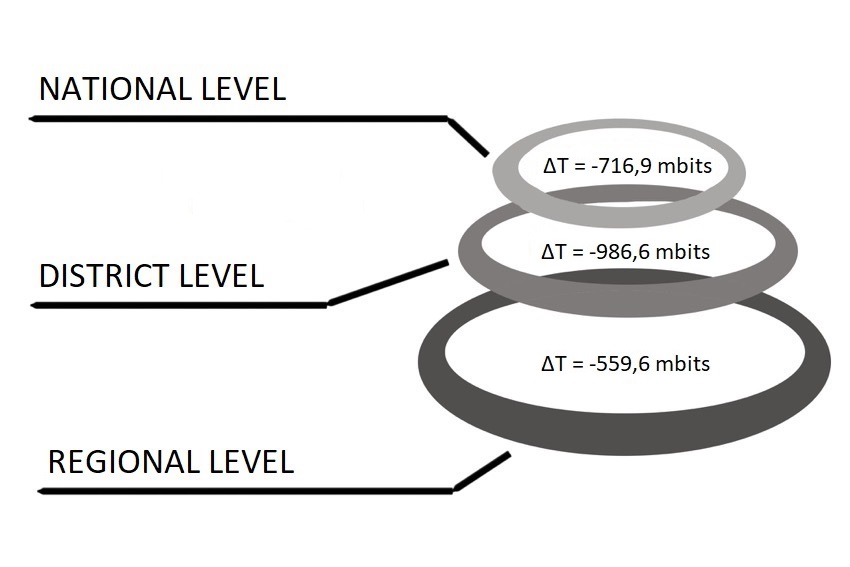
Thus, we can assume that the reason for the insufficient integration of technologically advanced companies at the regional level is the incomplete interaction of the academic and business environment, which is explained by the underestimation of university education involvement factor by high-tech companies.
Research Questions
American researchers (Unger & Polt, 2017) examined the channels, modes of interaction and policy instruments that provide knowledge exchange between academic institutions, as well as their transfer to business and society. Some ways of interaction are used by outside actors, for example companies, to transform the products of scientific and educational activities of universities into innovations, other ways of interaction have arisen due to the entrepreneurial activity of the universities themselves (the creation of accompanying project solutions – spin-offs, patenting and other activities, often generalized by the term "commercialization"). Often, informal communities become a prerequisite for formal cooperation. To effectively implement this kind of interactions that contribute to the innovative development of society, it is necessary to create an understandable and justified model of interaction between actors in the innovation process, as well as to resolve the issue of choosing priority areas for cooperation. Thus, our research question is: what should be the model of interaction between the state-university-business that is suitable for the Russian market and how can it be possible to solve the problem of choosing the most priority areas of cooperation, thereby increasing the effectiveness of the overall model as a whole?
Purpose of the Study
The aim of the study is to develop a model for effective cooperation between universities and business structures, which allows selecting the best joint projects, motivating actors to engage in constant joint research, generating successful innovative developments through the sharing of knowledge and experience, and which is capable of leading the country to a new level of society development.
Research Methods
As the main methods of research were the methods of system analysis, forecasting and optimization. The situation has been studied and analyzed in the sphere of interactions between universities, business structures and government bodies in Russia and abroad, and the strengths of existing models of interaction have been revealed and were included in a new proposed by us model.
Findings
A new stage in the development of society gives knowledge a great power in public life (Almazova, Baranova, & Khalyapina, 2017; Bylieva, Lobatyuk, & Rubtsova, 2018). Knowledge-creation is a continuous process in which knowledge is generated and then used to generate competitive advantage (Lynch & Jin, 2016). The knowledge creation process itself is not linear, in this connection, it is necessary to create a special universal model of knowledge generation, where universities as the main creators of this knowledge must introduce a new function in modern conditions and act as integrators (Reznik & Kurdova, 2017; Strongin, Maximov, & Groudzinski, 2005).
The study (Perez Vico, Schwaag, Serger, Wise, & Benner, 2017) stated that in order to strengthen ties in the knowledge triangle, Swedish universities perform three key tasks, one of which is directly responsibility for integration processes. By "integration function" we mean the organization of processes of interaction of elements in a complex system to ensure its development (Barykin & Kobicheva, 2018). In a particular case, we consider information interaction, which is a process of joint production, exchange and transfer of knowledge (many universities create knowledge transfer offices (Martín-Rubio & Andina, 2016). The university plays the role of a leading participant and an organizational mediator for the cooperation of the academic environment, business environment and government structures. The main goal of this cooperation is to unite efforts to solve interdisciplinary problems in the educational and scientific spheres, as well as activities aimed at innovation introduction.
According to the American scientist (Etzkowitz, 2008), innovations are formed as follows: the institutional spheres in the triple helix of the model partially overlap each other, people from different spheres meet, and new ideas appear. Thus, such a model becomes balanced. Institutional spheres fulfil their traditional roles, but they also acquire new functions. We, in turn, would like to demonstrate the cumulative role of the university factor in the process of interaction between the entrepreneurial, governmental and research spheres, as at the borders of the intersection of the three spheres the integration function actively enters into operation, ensures management and, as efficiently as possible, allows to generate the maximum amount of new knowledge.
Taking as a basis the model of the triple helix, we propose to build a model of interaction between the actors of the innovation process in the Russian Federation. In our model, the integration function of universities is linked by a common thread of information flow of three dynamic and constantly developing actors of the innovation economy (government - university - business) (Fig. 3). The locus of the function is located in the centre of the model, and the core or "information genome" prompts all drivers to create multi-layered communications, networks and organizations among spirals. Although the spirals of institutional spheres are constantly developing and transforming new information, the integration function does not lag behind, but is modernized and adapted to new conditions, helping to interact with actors at each level of their development. Universities in the process of implementing the integration function create innovative knowledge transfer schemes based on digital technologies, new methods for calculating the attractiveness of joint projects with the industry, thereby increasing the return on investment, universities are responsible for management innovations during the integration process, and monitor compliance with intellectual property rights.
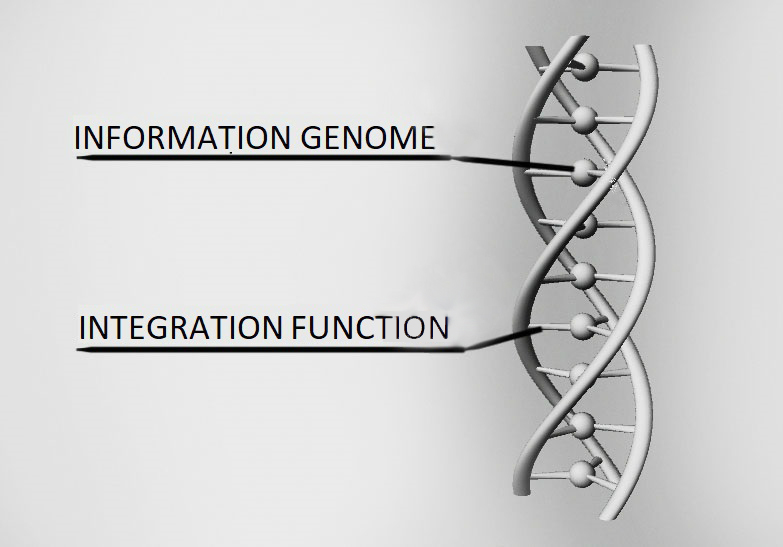
In addition, we would like to show that in the model we propose, the flow of new knowledge, projects and researches is controlled and carefully selected in the process of transition from the regional level to the district level, and then from the district level to the highest level - the national level, thus at the federal level there are the most priority and the most significant development (Fig. 4).
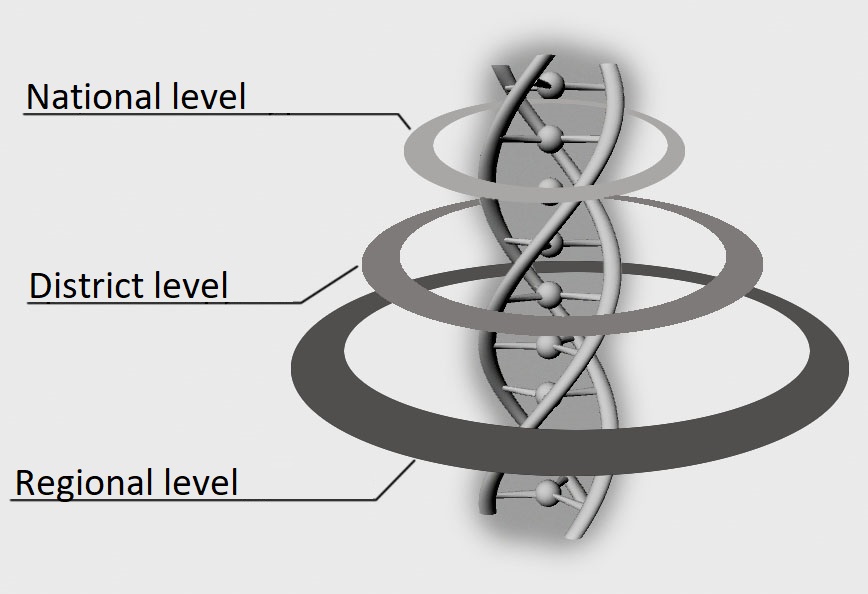
The implementation of this selection is possible on the basis of the following methodology of the investment program formation for joint innovative projects of universities and business structures, which includes seven stages:
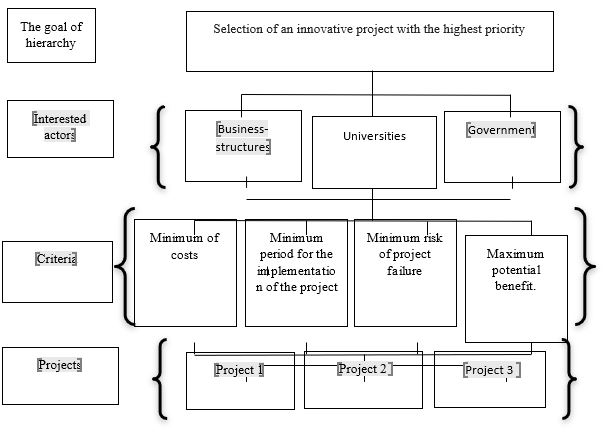
minimum of costs;
minimum period for the implementation of the project;
minimum risk of project failure;
maximum potential benefit.
The matrix elements of pair comparisons of elements of each hierarchy level are filled.
Comparisons are conducted on the basis of expert analysis, using a scale to identify the relative importance of the compared elements (Table
For each of the obtained matrices of pair comparisons of elements of all hierarchy levels the value ars is calculated, reflecting the degree of superiority of the compared element r over the element s in accordance with the element comparison scale (the indices r and s refer to the row and column, respectively):
, (1)
where
, – he quantitative value of relative importance in accordance with the scale (Table
Then, the priorities of the compared items are calculated :
, (2)
where – the geometric mean of the elements to N.
Thus, according to formulas (1) and (2), the following values are defined:
weight of each interested actor of innovation activities – (influence of the j-th actor on the implementation of the innovative project);
criteria weight – (the significance of the k-th criterion for the j-th actor);
project priorities for each criterion – (priority of the project, reflecting the contribution of the i-th project to the achievement of the k-th goal).
First, the criteria are weighed for each actor:
(3)
where j = 1, 2, 3 –sequence number of the interested actor; – weight of the k-th criterion for all groups of persons.
Formula (4) allows us to obtain the normalized weights of the criteria :
. (4)
Then the project priorities obtained as a result of decisions (1) and (2) are weighed by the criteria weights.
, (5)
where k = 1, 2, 3, 4 – sequence number of the criterion; i = 1, 2, …, n – sequence project number; – priority of the i-th project, showing its contribution to the achievement of the set goals.
. (6)
Thus, this methodology for selecting a funding program for a priority joint innovation project of the university and business structures is developed on the basis of the multiplicative method of analyzing hierarchies as a multi-criteria approach to the analysis of complex problems proposed by the Dutch scientist Lootsma (Lootsma, 1993). The developed methodology allows to implement the optimal program for financing projects taking into account the interests of the university, business structures, and government, as well as the set goals for the main actors of the innovation process.
Conclusion
The model of interaction between universities, business structures and government, based on the integration function of higher schools and the proposed method of choosing the optimal direction of interaction, can lead the Russian economy to a new level of development, increasing the efficiency and effectiveness of all forms of joint cooperation.
References
- Aladyshkin, I., Kulik, S., Michurin, A., & Anosova, N. (2017). Information Prospects For Socio-Cultural Development: Contradictory Grounds RPTSS 2017 International Conference on Research Paradigms Transformation in Social Sciences, The European Proceedings of Social & Behavioural Sciences EpSBS, Vol. XXXV, 19-25. doi: 10.15405/epsbs.2018.02.3
- Almazova N.I., Baranova T.A., & Khalyapina L.P. (2017). Pedagogical approach and models of integrated foreign languages and professional disciplines teaching in foreign and Russian linguodidactics. Sciencific journal of Language and Culture, 7, doi: 10.17223/19996195/39/8
- Barykin S., & Kobicheva. A. (2018). Logistical approach to universities integration in the Russian innovation economy, MATEC Web of Conferences, Vol. 170, 01-20.
- Bylieva, D., Lobatyuk, V., & Rubtsova, A. (2018). Homo Virtualis: existence in Internet space SHS Web of Conferences 44, 00021 (2018) CC-TESC2018. DOI: 10.1051/shsconf/20184400021
- Etzkowitz. H. (2008). The Triple Helix: University-Industry-Government Innovation In Action. London: Routledge.
- Evseeva L., Obukhova J., & Tanova A. (2017). Network technologies and the new perception of communication” 4th International Multidisciplinary Scientific Conference on Social Sciences and Arts. SGEM. Book6, Vol.1, 57 – 64. DOI:10.5593/SGEMSOCIAL2017/HB61/S7.07
- Hohmann, L., (2016). To what Extent Is the Triple-Helix-Model of Etzkowitz & Leydesdorff of Use for the Implementation of Smart Governance? – an Analysis Referring on Implemented Triple Helix-Constellations. Glocality, 2(1), p.2.
- Leydesdorff, L., Perevodchikov, E., & Uvarov, A. (2015). Measuring triple-helix synergy in the Russian innovation systems at regional, provincial, and national levels. Journal of the Association for Information Science and Technology, 66 (6), 1229-1238.
- Leydesdorff, L. , Wagner C. S., Porto-Gomez I., Comins J. A., & Phillipse F. (2017, October 30). Synergy in the Knowledge Base of US Innovation Systems at National, State, and Regional Levels: The Contributions of High-Tech Manufacturing and Knowledge-Intensive Services, Journal of the Association of Information Science and Technology. Retrieved from https://arxiv.org/abs/1710.11017v1
- Lootsma, F. A. (1993). Scale Sensitivity in the Multiplicative AHP and SMART. Journal of Multi-Criteria Decision Analysis, Vol. 2, pp. 87 – 110.
- Lynch, R., & Jin, Z. (2016),.Exploring the institutional perspective on international business expansion: Towards a more detailed conceptual framework. Journal of Innovation & Knowledge, 1 (2), pp. 117-124
- Martín-Rubio, I., & Andina, D. (2016). University knowledge transfer offices and social responsibility. Administrative Sciences., 6(4).
- Mayer-Schoenberger, V., & Cuciere, K. (2014). Large data. A revolution that will change how we live, work and think. M.: Mann, Ivanov and Ferber.
- Perez Vico, E., Schwaag Serger, S., Wise, E., & Benner, M. (2017) Knowledge Triangle Configurations at Three Swedish Universities. Foresight and STI Governance, vol. 11, no 2, 68–82. doi: 10.17323/2500- 2597.2017.2.68.82
- Reznik, G.A., & Kurdova, M.A. (2017). Functions of Russian university during formation of innovation-based economy. Integratsiya obrazovaniya = Integration of Education.; 21(3), 441-458. doi: 10.15507/1991-9468.088.021.201703.441-458
- Strongin, R.G. Maximov, G.A., & Groudzinski, А.О. (2005). University as an Integrator in the Knowledge-Based Society. Nizhni Novgorod University Press.
- The concept of long-term socio-economic development of the Russian Federation for the period until 2020 (developed by the Ministry of Economic Development of Russia). (2014). The legal consultant system "Consultant Plus”.
- Unger, M., & Polt, W. (2017). The Knowledge Triangle between Research, Education and Innovation — A Conceptual Discussion. Foresight and STI Governance,vol. 11, no 2, 10–26.
Copyright information

This work is licensed under a Creative Commons Attribution-NonCommercial-NoDerivatives 4.0 International License.
About this article
Publication Date
30 December 2018
Article Doi
eBook ISBN
978-1-80296-050-1
Publisher
Future Academy
Volume
51
Print ISBN (optional)
-
Edition Number
1st Edition
Pages
1-2014
Subjects
Communication studies, educational equipment,educational technology, computer-aided learning (CAL), science, technology
Cite this article as:
Kobicheva, A. (2018). The Structures Interaction Model Of Universities And Business. In V. Chernyavskaya, & H. Kuße (Eds.), Professional Сulture of the Specialist of the Future, vol 51. European Proceedings of Social and Behavioural Sciences (pp. 407-415). Future Academy. https://doi.org/10.15405/epsbs.2018.12.02.44

